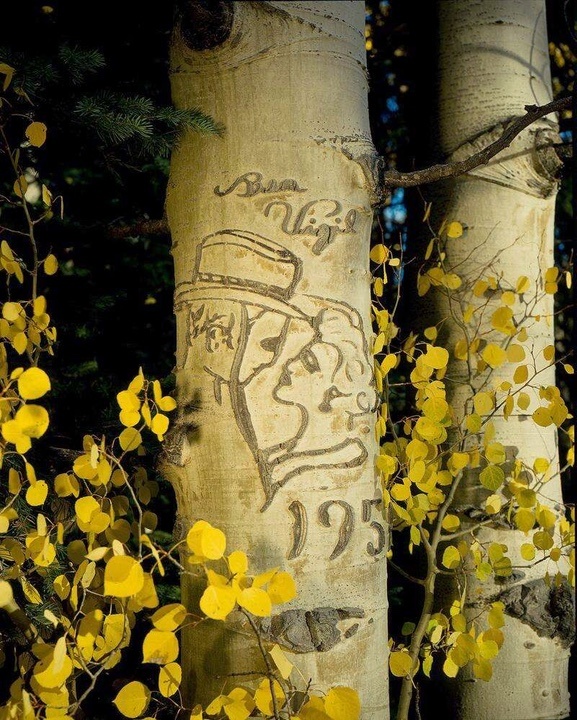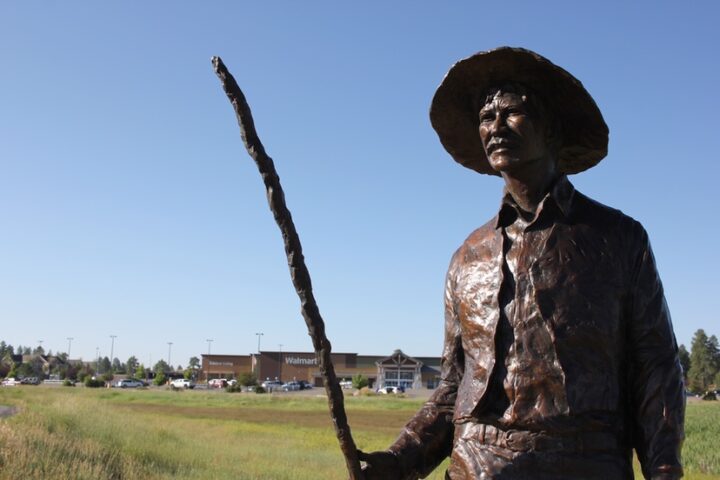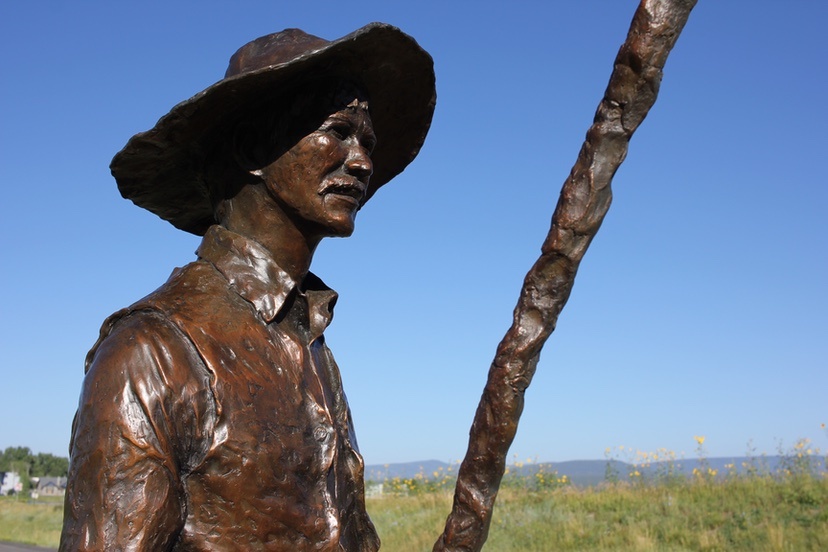As mentioned in Part One, the official name for Chad Haspels’ new bronze sculpture, now installed next to the Aspen Village walking path, is “Weminuche Meadows.” Historically, Archuleta County sheepherders drove their flocks up into the high mountain meadows for the summer… where the sheep and lambs could graze the abundant herbs that nature provided. Before the arrival of the U.S. Forest Service, the meadows were available under Colorado’s open grazing laws.
Available, unless perhaps some local cattle ranchers objected? And brought along their firearms?
We heard a story about one such conflict between cattle ranchers and sheepherders during the dedication of the “Weminuche Meadows” sculpture on Saturday.
Saturday also happened to be the date for the 22nd annual Spanish Fiesta, held at the Fairgrounds, and I assume the Town of Pagosa Springs scheduled the dedication of Mr. Haspel’s sculpture for the same day, as an additional way to honor local Hispano culture.
Given that most of the sheepherders in Archuleta County — the borregeros — came from that Hispano culture.
The cattle ranchers in Archuleta County, on the other hand, typically embraced the Anglo culture. So differences existed, not only in the choice of livestock, but also in the choice of culture, language, and religion.
This is a new word in my vocabulary. “Hispano”. The word appeared in the essay we posted last Thursday, written by Town Council member J. Leonard Martinez: “Where Have All the ‘Borregeros’ Gone…?” In that essay, Mr. Martinez shared a story about his family’s involvement in Archuleta County’s Spanish heritage — in particular, the life of the sheepherder, the borregero of this region.
When I first moved to Pagosa in 1993, I understood that the community included a mix of cultures, one of which was referred to as “Spanish”. We still use that term, as evidenced by the name of Saturday’s cultural celebration: “Spanish Fiesta”.
The Spanish culture of the American Southwest is considered, by many, to be distinct from “Mexican” culture, although the two traditions share many cultural practices and values, including the Spanish language, the Catholic religion, and perhaps most importantly, a pattern of close family ties. Many of the Spanish families in southern Colorado and northern New Mexico descend from ancestors who settled here prior to Mexican independence… and prior to the Mexican-American War and the acquisition of the Colorado Territory by the U.S. government.
So, then, “Spanish”… rather than “Mexican”. Or as I am now learning, “Hispano”… rather than, say, “Latino” or “Chicano”.
At the Saturday dedication of the new bronze sculpture on Saturday, the Spanish Fiesta Royalty — the Queen and attendant Princesses — stood near the sculpture while local sculptor Chad Haspels explained how the sculpture had come into existence.
“When I first came to Pagosa in 1998, out of college, I had a job with the Forest Service — the Pagosa Ranger District… and the biggest thing I noticed was the impact and level of influence the Hispano culture had here in Pagosa. So when the call to artists came about, they were looking for something that spoke to the history of Pagosa, to me, it was a natural fit with the Hispano culture, which Leonard will speak to. And I couldn’t keep that out of my mind… and everything kept coming back to this theme. It’s such a big part of Pagosa, and the Hispano culture here today is so vibrant, and such a core part of Pagosa…”
As I thought about the meaning of this art piece, and its role in telling our history, I went back in my memory to a walking tour many years ago, up in the meadows of the San Juan Mountain foothills. The tour leader, Peggy Bergon, had been for many years documenting the ‘arborglyphs’ created by the borregeros. These were drawings and messages inscribed on aspen trees, some dating back to the late 1800s, and some from as recent as the 1960s.
The bark of the aspen tree is very tender, and marks scratched into its surface with a sharp object — a knife? a nail? a ball point pen? — eventually darkens and becomes a permanent scar. Here’s a sample arborglyph photographed by Bill and Beth Sagsetter in northern Colorado, signed by sheepherder Ben Vigil. (Courtesy of Beth Sagstetter.)

Since the 1970s, Peggy. Bergon has photographed hundreds of similar drawings and messages in our local San Juan mountains. During our tour, I began to get an understanding of the difficult life led by the borregeros, high in the mountain meadows, often alone with their flock and sheep dogs for several months of the summer… protecting the flock from coyotes and bears, moving 1,000 sheep to a new meadow as necessary, dealing with the birth of lambs. I can imagine the work — as lonely as it might be — leaving a considerable amount of time for pondering the meaning of life.
Some of that pondering ended up etched into the aspen trees.
I stopped by to visit the sheepherder sculpture on Sunday, July 28, the day after the dedication, to see how he was doing. He was no longer surrounded with an appreciative audience; in fact, he looked a bit lonely, standing there and gazing to the northeast, in the general direction of the mountain meadows.
Looking for his sheep?

From a 2018 online article by Durango historian Andrew Gulliford:
Everybody writes about cowboys. Nobody writes about sheepherders.
Of the hundreds of books written about cowboys and cowboying in the American West, there are few volumes on sheep and sheepmen. So I set out to write the first full-length history on the sheep and cattle wars in Colorado and modern sheep grazing on public lands. The book, “The Woolly West: Colorado’s Hidden History of Sheepscapes,” is published now. I hope I didn’t do a baaaaaaaaaad job.
A lone sheepherder would be in charge of a band of about 1,000 sheep, and though he might have had a horse, it was really his dogs that kept the sheep in line, bedded them down and guarded them through the night against coyotes and bears. In the herding tradition, the morning star is the shepherd’s star — ‘La Estrella del Pastor’ — because herders rise in the dark.
Cowboys get the fancy hats and hand-tooled leather boots. Sheepherders wear whatever they can find and carry a staff or crook to catch errant sheep by a rear hoof. It’s an ancient practice, far older than 19th-century cowboying and trailing cattle north to railroad terminus points as America moved west. Sheepherding stories and metaphors abound in the Bible and in diverse cultures worldwide…
The fact that many of the famous people in the Bible were sheepherders, didn’t prevent Archuleta County cattle ranchers from engaging in hostile conflicts with the borregeros.
At the sculpture dedication on Saturday, we heard a story about just such a conflict, told by a family member… in fact, by one of the Spanish Fiesta Royalty, Lillyan Vega…

